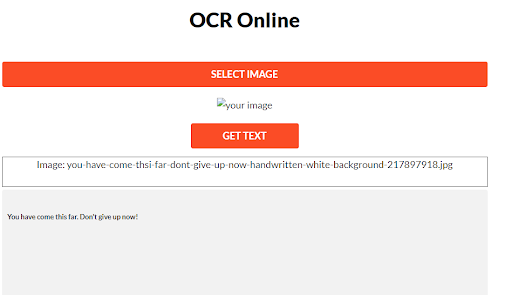Have you ever felt the need of converting your printed documents into digital form? The printed documents are hard to collect, sort, and analyze. A big chunk of your productive energy gets wasted because of that. However, there is one technology that can solve this problem.
What is OCR?
The OCR stands for optical character recognition. The technology is used to extract text from every type of image. The input can be in the form of JPG, PNG, GIF & SVG formats. The technology has shown above 90% accuracy in little to complex conversions.
Currently, the whole world is shifting towards OCR to get rid of all printed documentation. The Global OCR market has touched USD 10.54 billion this year. The market has tipped to show a growth rate of 15.4% during the 2022-2030 period.
The technology is being used in banking, retail, manufacturing, healthcare, legal works, government institutions, and all other businesses. The professionals are also adopting at a personal level to make their data more sorted and organized.
How does OCR Work?
Every online OCR software follows these fundamental steps to identify the comprehendible text from an image.
- Image Extraction
In the first phase, the OCR software works on detaching text from the original specimen. The software divides the image into two areas: light and dark.
The light region represents the background while the dark represents the text. This helps in quick conversions.
- Preprocessing
This phase works on improving the quality of the image to help the tool in better identification. The general techniques used for that are:
Deskewing an image to resolve internal alignment issues
Despecking to remove any probable digital spots and make the edges smooth.
Cleansing boxes and lines from the input image
Script original for identification of multi-lingual text
- Text Recognition
In this phase, the tool identifies the text present in the image. This can be done in two simple ways:
Pattern Identification: In this method, the OCR tool uses optical media to recognize the input data. This data is then compared with the tool’s internal database to find commonality. This commonality gives it a comprehendible meaning.
Intelligent Identification: This method utilizes artificial intelligence to directly recognize the input data.
- Post Processing
This is the final step. The device simply converts the recognized data into comprehensible human speech. The tool uses NLP, natural language processing for this conversion. The most common technique for conversion is ASCII.
Practical Demonstration of OCR
Till now, we have explained the intro and process behind OCR conversion. This section will show you a practical demonstration.
For converting, all you need is to select your desired image. And upload it on an efficient online OCR Tool in a supported format. After that just simply click the proceed option to detach the desired text.
We posted the following image for conversion:

This is how our selected tool, OCR Online, converts it.

You can see that the whole text has been extracted without any loss of character or expression. You can repeat this same method for all such conversions.
What are the advantages of OCR?
The OCR has revolutionized the way we work. The OCR has aided in bringing the tech revolution to induvial and business levels. Today, if you don’t use OCR, you would be left behind among your peers.
These are the key advantages that OCR provides:
Ease of Data Compilation
The OCR ensures real-time image-to-text conversions. The manual typing of text from a document can take hours of your productive time.
Like in the field of law, you need to read past cases, modern interpretations, and other citations from all over the world. You probably need a separate department just for printing and storing the documents.
With OCR you can compile all this data in real-time. Ensuring the ease of data compilation.
Faster Data Access
Digital data provides ease of access. For printed documents, you need a whole library to save and sort your business or personal documentation.
The organization used to have a store department, having multiple store keepers just to store the important documents. Even after all this arrangement, the data access was slower.
The digital data is easy to configure. All your data is available with one click. You can reach your selected file with its reference.
Process Automation
The advanced OCR system improves the functionality of all associated processes in a business. It connects them to a central database. This makes things quicker and more efficient.
For Example, in a manufacturing line, the OCR scan can detach the authenticity of incoming material, required machinery, and operations working on your task. You don’t need human verification now.
Similarly, it helps in employee identification, supply chains, and managing business transactions.
Human Resource Management
For any success, the managers need to work on the utilization of human resources. The documentation and clerical side are important for keeping track and checking on overall performances. But it in a way, is also a hindrance to overall productivity.
With OCR you can automate normal clerical works, business reporting, and all other documentation. Also, as a manager, you no longer have to verify minuscule materials and processes.
The OCR can auto-fill the routine data and connect it with the centralized database. Allowing the managers to use their force for higher productivity and efficiency.
Better Customer Relations
The OCR allows for faster customer feedback. You can float an online form, which can be filled by your customers with certain IDs. This form can contain questions about your product, services, and future market forecast.
The businesses run on customer satisfaction. Large-scale manufacturers have a separate department of “Customer Relations”. The OCR gives instant results from customer ends.
Based on that, you can improve your product and services as per the market demand.
Transparency
Transparency is important at both personal and organizational levels. Businesses run on their credibility and transparency.
The OCR brings transparency to data compilation and storage. There isn’t any possibility of human malfunctioning. This develops the trust between customers and the organization, and also among the employees of the organization.
For example, the manual verification of written cheques was always problematic. It often resulted in customer dissatisfaction. The payment transfer was also slower.
However, with OCR you can do real-time scans to identify the numbers and signatures. It has also automated it by connecting with the central bank. Today, the transfer is quicker and more transparent.
Data Analytics
In the modern world, the data sciences have touched unprecedented heights. Every organization is using it to identify their weak areas and improve them for better success.
For example, while analyzing sales of your product, you need to incorporate all factors affecting it. The study shall include market trends, customer hot spots, demand, pricing, quality, ease of access, design efficiency, and all other factors affecting sales.
With OCR you can arrange all these datasets into one case study. And then work on devising a comprehensive plan. A well-thought plan ensures long-term success.
Final Words
The ORC has emerged as a game changer in the collection, sorting, analysis, and interpretation of information. The blog post has highlighted its advantages for businesses.
Do give it a read and let us know your insights about the technology.





